Installation, Storage, and Compute with Windows Server 2016 v1.0
Question 1
HOTSPOT -
Note: This question is part of a series of questions that use the same scenario. For your convenience, the scenario is repeated in each question. Each question presents a different goal and answer choices, but the text of the scenario is exactly the same in each question in this series.
A company named Contoso, Ltd. has several servers that run Windows Server 2016. Contoso has a Hyper-V environment that uses failover clustering and
Windows Server Update Services (WSUS). The environment contains several Windows containers and several virtual machines.
The WSUS deployment contains one upstream server that is located on the company"™s perimeter network and several downstream servers located on the internal network. A firewall separates the upstream server from the downstream servers.
You plan to deploy a human resources application to a new server named HRServer5. HRServer5 contains a FAT32-formatted data volume.
The CIO of Contoso identifies the following requirements for the company"™s IT department:
- Deploy a failover cluster to two new virtual machines.
- Store all application databases by using Encrypted File System (EFS).
- Ensure that each Windows container has a dedicated IP address assigned by a DHCP server.
- Produce a report that lists the processor time used by all of the processes on a server named Server1 for five hours.
- Encrypt all communication between the internal network and the perimeter network, including all WSUS communications.
- Automatically load balance the virtual machines hosted in the Hyper-V cluster when processor utilization exceeds 70 percent.
You need to create a Data Collector Set to meet the requirement for the processor time report.
What command should you run to create the Data Collector Set? To answer, select the appropriate options in the answer area.
Hot Area:

Answer : 
Question 2
Your network contains a new Active Directory domain named contoso.com.
You have a security policy that states that new servers should run Nano Server whenever possible.
Which server role can be deployed on a Nano Server?
- A. Active Directory Domain Services
- B. DHCP Server
- C. Network Policy and Access Services
- D. Web Server (IIS)
- E. Remote Desktop Services
- F. Windows Server Update Services
Answer : D
Explanation:
Question 3
You have a server named Server1 that runs Windows Server 2016.
The Windows Server 2016 installation media is mounted as drive D.
You copy the NanoServerImageGenerator folder from the D:\NanoServer folder to the C:\NanoServer folder.
You need to create a custom Nano Server image that includes the Hyper-V server role. The image will be used to deploy Nano Servers to physical servers.
Which two commands should you run? Each correct answer presents part of the solution.
- A. New-NanoServerImage ""Edition Standard ""DeploymentType Guest ""MediaPath D:\ -TargetPath .\NanoServerImage\NanoServer.wim ""Compute
- B. Install-PackageProvider NanoServerPackage
- C. Import-PackageProvider NanoServerPackage
- D. New-NanoServerImage ""Edition Standard ""DeploymentType Host ""MediaPath D:\ -TargetPath .\NanoServerImage\NanoServer.wim ""Compute
- E. Import-Module C:\NanoServer\NanoServerImageGenerator
Answer : DE
Explanation:
References:
https://technet.microsoft.com/en-us/windows-server-docs/get-started/nano-server-quick-start
Question 4
DRAG DROP -
You have a network that contains several servers that run Windows Server 2016.
You need to use Desired State Configuration (DSC) to configure the servers to meet the following requirements:
- Install the Web Server server role
- Start the World Wide Web Publishing service.
How should you configure the DSC resources? To answer, drag the appropriate values to the correct locations. Each value may be used once, more than once, or not at all. You may need to drag the split bar between panes or scroll to view content.
Select and Place:
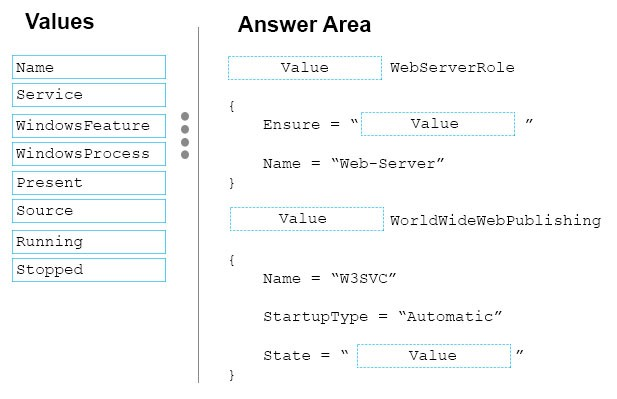
Answer : 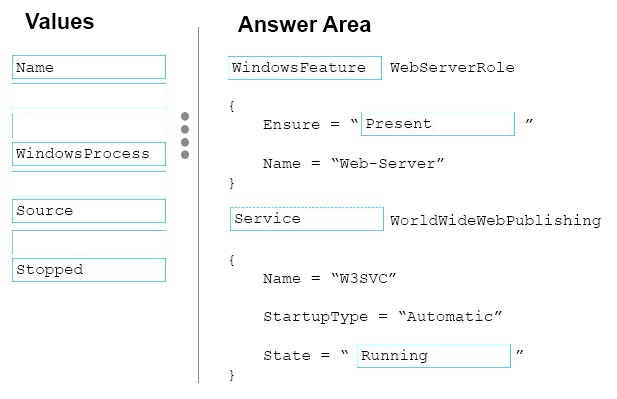
Question 5
You have a server named Server1 that runs Windows Server 2016.
You need to install the DNS Server role on Server1.
What should you run?
- A. the Install-Package cmdlet
- B. the Add-WindowsPackage cmdlet
- C. the Install-WindowsFeature cmdlet
- D. the setup.exe command
Answer : C
References:
https://docs.microsoft.com/en-us/powershell/module/servermanager/install-windowsfeature?view=winserver2012r2-ps
Question 6
You have a server named Server1 that runs Windows Server 2016.
Server1 has Internet connectivity.
You have a Nano Server image.
You need to download and save a Nano Server package in the Nano Server image. The package is NOT included in the Windows Server 2016 installation media.
Which two cmdlets should you run on Server1? Each correct answer presents part of the solution.
- A. Set-PackageSource
- B. Install-PackageProvider
- C. Add-AppxProvisionedPackage
- D. Save-NanoServerPackage
- E. Add-WindowsPackage
Answer : BD
Explanation:
Question 7
You have a server named Server1 that runs Windows Server 2016 and has the Hyper-V server role installed.
On server1, you plan to create a virtual machine named VM1.
You need to ensure that you can start VM1 from the network.
What are two possible ways to achieve the goal? Each correct answer presents a complete solution.
- A. Create a generation 2 virtual machine.
- B. Create a generation 1 virtual machine and run the Enable-NetAdapterPackageDirectcmdlet.
- C. Create a generation 1 virtual machine that has a legacy network adapter.
- D. Create a generation 1 virtual machine and configure a single root I/O virtualization (SRV-IO) interface for the network adapter.
Answer : AC
Explanation:
Question 8
HOTSPOT -
You have a server named Server1 that runs Windows Server 2016 and has the Hyper-V server role installed.
You open Disk Management on Server1 as shown in the following graphic.
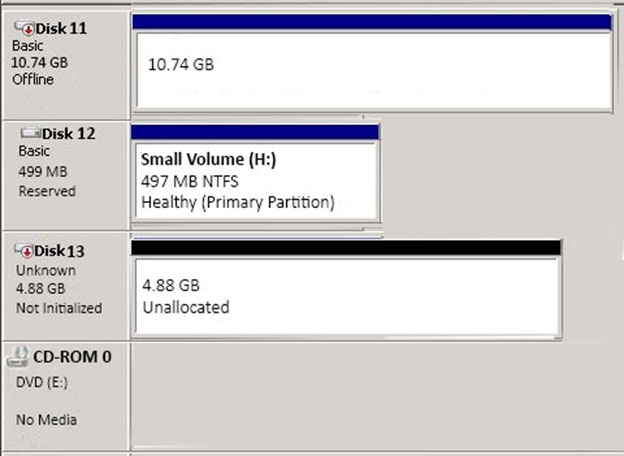
You plan to configure Disk 13 as a pass-through disk for a generation 1 virtual machine.
Use the drop-down menus to select the answer choice that completes each statement based on the information presented in the graphic.
Hot Area:
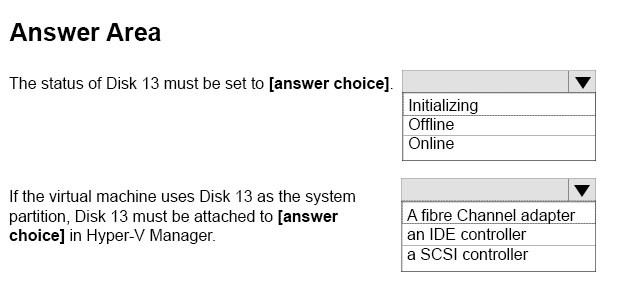
Answer : 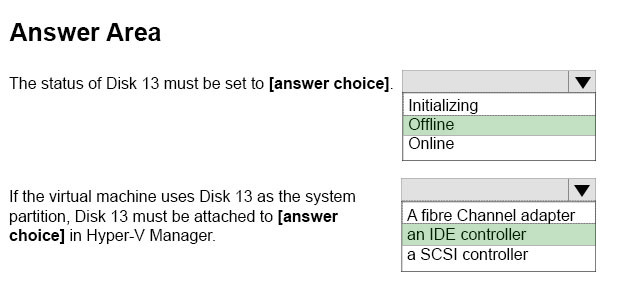
References:
https://blogs.technet.microsoft.com/askcore/2008/10/24/configuring-pass-through-disks-in-hyper-v/
Question 9
HOTSPOT -
You have a Hyper-V host that runs Windows Server 2016. The Hyper-V host has a virtual machine named VM1.
You have a VHD named VHD1.vhdx that has a generalized image of Windows Server 2016.
You plan to create multiple virtual machines that will use the generalized image.
You need to create differencing disks based on VHD1.vhdx.
What command should you run? To answer, select the appropriate options in the answer area.
Hot Area:
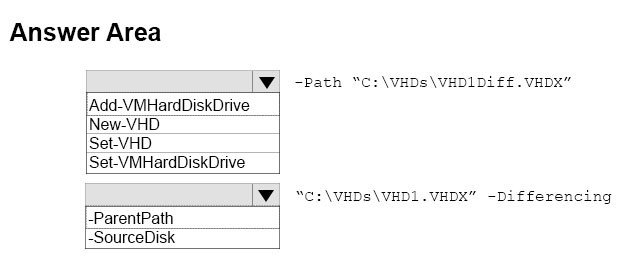
Answer : 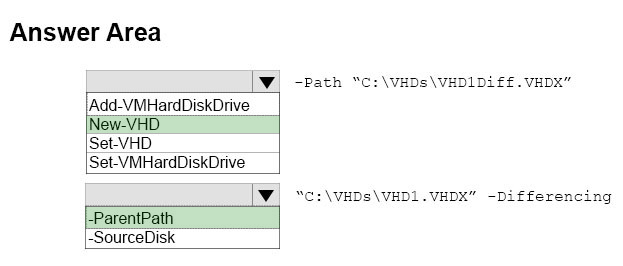
Question 10
You have a Hyper-V host that runs Windows Server 2016. The host contains a virtual machine named VM1. VM1 has resource metering enabled.
You need to use resource metering to track the amount of network traffic that VM1 sends to the 10.0.0.0/8 network.
Which cmdlet should you run?
- A. Add-VMNetworkAdapterAcl
- B. Set-VMNetworkAdapter
- C. New-VMResourcePool
- D. Set-VMNetworkAdapterRoutingDomainMapping
Answer : A
Explanation:
Question 11
DRAG DROP -
Your network contains two Hyper-V servers named Server1 and Server2. Server1 has Windows Server 2012 R2 installed. Server2 has Windows Server 2016 installed.
You perform a live migration of a virtual machine named VM1 from Server1 to Server2.
You need to create a production checkpoint for VM1 on Server2.
Which three Windows PowerShell cmdlets should you run in sequence? To answer, move the appropriate Windows PowerShell cmdlets from the list of actions to the answer area and arrange them in the correct order.
Select and Place:
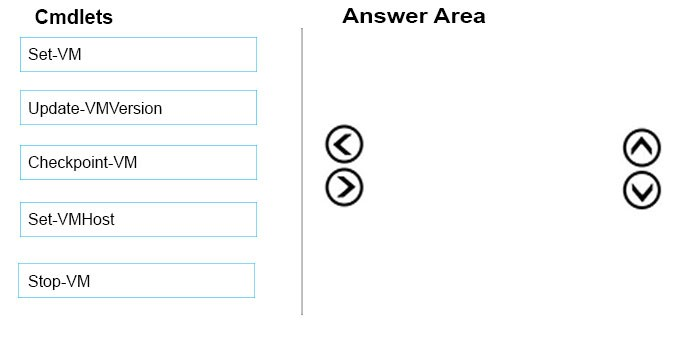
Answer : 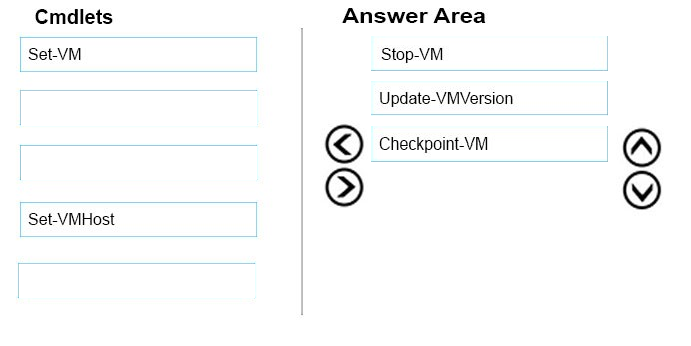
Question 12
You have a Hyper-V host named Server1 that runs Windows Server 2016. Server1 has two virtual machines named VM1 and VM2.
You discover that VM1 and VM2 can communicate with Server1 over the network.
You need to ensure that VM1 and VM2 can communicate with each other only. The solution must prevent VM1 and VM2 from communicating with Server1.
Which cmdlet should you use?
- A. Set-VMSwitch
- B. Enable-VMSwitchExtension
- C. Set-NetNeighbor
- D. Remove-VMSwitchTeamMember
Answer : A
Explanation:
Question 13
DRAG DROP -
You are planning the configuration of a virtual network switch for a Hyper-V environment. The environment will contain the following Hyper-V hosts:
- A server named Server1 will have 10 virtual machines that must be able to communicate with each other. The virtual machines must be prevented from communicating with Server1 and all other servers on the corporate network.
- A two-node failover cluster named Cluster1 will have 20 virtual machines. The virtual machines will run on both nodes. Hyper-V hosts on the corporate network must be able to connect to the virtual machines.
Which type of virtual switch should you select for each Hyper-V host? To answer, drag the appropriate virtual switch types to the correct hosts. Each virtual switch type may be used once, more than once, or not at all. You may need to drag the split bar between panes or scroll to view content.
Select and Place:

Answer : 
Question 14
You have a Hyper-V host named Server1 that runs Windows Server 2016. Server1 contains four virtual machines that are configured as shown in the following table.

To which virtual machine or machines can you connect by using Virtual Machine Connection from Hyper-V Manager?
- A. VM1, VM2, VM3, and VM4
- B. VM4 only
- C. VM1 and VM2 only
- D. VM3 and VM4 only
- E. VM2 only
Answer : D
Explanation:
Question 15
Note: This question is part of a series of questions that use the same or similar answer choices. An answer choice may be correct for more than one question in the series. Each question is independent of the other questions in this series. Information and details provided in a question apply only to that question.
You have a two-node Hyper-V cluster named Cluster1 at a primary location and a stand-alone Hyper-V host named Server1 at a secondary location.
A virtual machine named VM1 runs on Cluster1.
You configure a Hyper-V Replica of VM1 to Server1.
You need to perform a Test Failover of VM1.
Which tool should you use?
- A. the clussvc.exe command
- B. the cluster.exe command
- C. the Computer Management snap-in
- D. the configurehyperv.exe command
- E. the Disk Management snap-in
- F. the Failover Cluster Manager snap-in
- G. the Hyper-V Manager snap-in
- H. the Server Manager app
Answer : G
Explanation: